Top 10 Checkout Optimization Strategies To Maximize Your Sales
The checkout process is one of the most significant elements an eCommerce business must focus on. You should never underestimate the power that your checkout process has on your customers’ decisions. With every potential customer, the quality of your checkout process determines whether you’ll get a successful sale or an abandoned cart.
If you own an eCommerce store or work at one, you know how bad a high cart abandonment rate can affect a business. For you to be able to overcome, among others, the problem of cart abandonment, you need to work on optimizing your checkout process.
The checkout process is defined as the series of steps that customers have to follow to buy the products or subscribe to the services they add to their cart on an eCommerce website. Your job is to ensure that these steps are as convenient as possible. An optimized checkout process reduces your cart abandonment rate while optimizing your conversion rate, which should be priorities for any eCommerce store wishing to succeed.
This article delves into checkout optimization by offering some of the best strategies you could use to provide your customers with the most smooth and frictionless checkout experience possible. The article also presents insightful examples.
Top 10 Checkout Optimization Strategies For E-Commerce
- Don’t force your customers to create an account.
- Offer as many payment methods as possible.
- Don’t surprise your customers with additional costs.
- Make your customers feel safe with security badges.
- Leverage cross-selling and up-selling at checkout.
- Provide customers with live chat support.
- Use FOMO marketing
- Make sure the checkout page is mobile-friendly
- Explain the checkout flow and display a progress indicator.
- Make sure you collect customers’ emails in an early stage.
1- Don’t force your customers to create an account
We understand that you want to gather as much data about your customers as possible and that having them create an account on your eCommerce website can grant you that. We also understand how crucial this data can be for retargeting and retention strategies. However, the benefits you can get from forcing them to create an account are not worth the harm it can cause to your conversions and sales.
In today’s fast-paced world, customers want to get through the checkout process as quickly and seamlessly as possible. For many, having to stop in the middle of the process to create an account represents friction in their shopping experience.
Therefore, one of the best strategies to optimize your eCommerce store’s checkout process is to provide a “Guest Checkout” option.
If you still need to ask your customers to create an account, you can do that right after they complete the purchase. You can also offer them incentives, such as discounts or promo codes, to encourage them to register.
Example: Nike
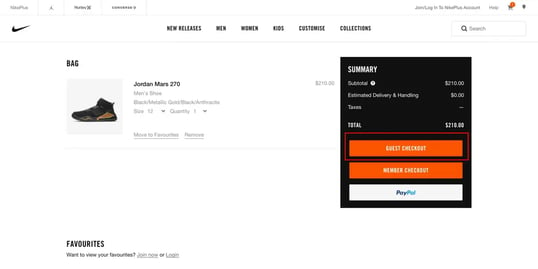 Image source: bolt.com
Image source: bolt.com
Notice how Nike is offering a great deal of flexibility within its checkout process. It provides a “Member Checkout” option for customers who want to log in to their existing account or those who wish to create a new one. At the same time, it offers a “Guest Checkout” option for customers who do not have the time or are not interested in registering right away.
2- Offer as many payment methods as possible
Another strategy that will help you optimize your checkout process is providing a variety of payment methods. Offering multiple payment methods can be costly, especially for small eCommerce stores. Therefore, we advise you to thoroughly understand your customers and identify which payment methods they prefer so that you would know which ones to invest in.
Of course, it would be very convenient if you could provide all the following payment methods:
- Cash.
- Debit Cards/Credit Cards.
- Shopping Apps, such as PayPal and Shop Pay.
- Digital Wallets, such as Apple Pay and Google Pay.
- Installment Plans, or what is known as “Buy Now, Pay Later.”
Make sure to disclose the available payment options early on in the checkout process. You don’t want the customer to arrive at the last step only to find that their preferred payment method is not accepted at your store. Customers need to be aware of that from the beginning.
In addition to offering multiple payment options, you should ensure that the payment section is easy to understand and navigate.
Example: Ulta Beauty
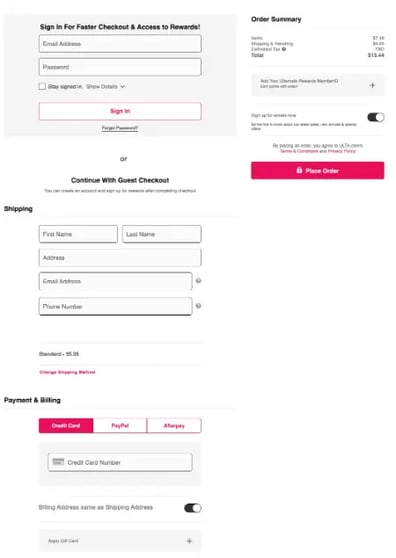
As you can see, the beauty eCommerce brand, Ulta Beauty, has a very well-optimized checkout process. The store offers a variety of payment methods, such as using a Credit Card, PayPal, or through AfterPay which allows for a deferred payment schedule.
If you have another look at the Ulta Beauty example, you’ll find that the store also implements the first strategy we discussed and offers a guest checkout for customers who do not have an account and do not want to create one.
3- Don’t surprise your customers with additional costs
Let’s keep this in mind: The key to an optimized checkout process is the elimination of all surprises. Nothing ruins a customer's shopping experience more than working their way through a checkout only to find unexpected costs added to the total of their purchase.
If there are any costs you’re planning to add to the total of a customer’s transaction, such as taxes, insurance, or even shipping costs, make sure the customer is aware of that from the beginning.
However, what’s even better and leads to better checkout optimization is to bundle these charges into the prices of your products or services instead of presenting them as additional costs.
Example: World Market
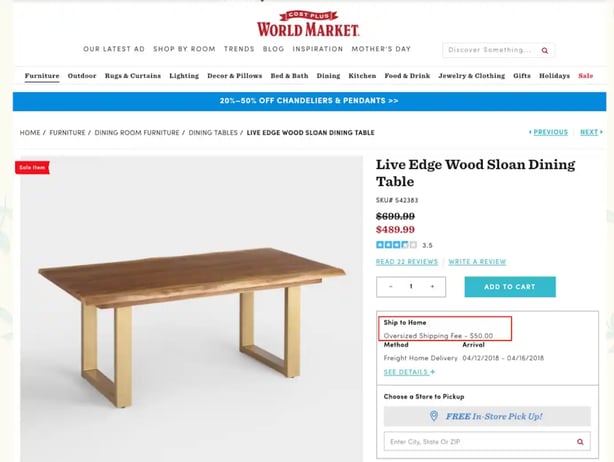
In this example, World Market disclosed the additional shipping charges on the product page, which is way before the start of the checkout process. However, for a more optimized checkout, you can display the additional charges in a bigger font and place them next to the CTA for more visibility.
4- Make your customers feel safe with security badges
Customers are becoming more cautious about their privacy online. Your job is to make them feel safe and convince them that your checkout is secure.
That’s why using security badges is another strategy that can optimize the checkout at your eCommerce store. Security badges have two main benefits:
- They make customers feel safe while entrusting you with sensitive information, such as their credit/debit card numbers.
- They establish your eCommerce brand as legitimate and reliable.
Another thing that can make your customers feel safe is to include customer testimonials.
At checkout?
Yes, at checkout.
Customer testimonials can create wonders by providing the exact amount of social proof that a customer needs to complete a purchase.
Example: Nick Mayer
.webp?width=563&height=263&name=Checkout%20Optimization%20Strategies%20example%20(1).webp) Image source: shopify.com
Image source: shopify.com
Nick Mayer is an online art store we can all learn from when discussing checkout optimization. As you can see, the store adds a bunch of security badges and a couple of customer reviews. So, the online store excels in using this strategy. However, if you’ve been paying attention to the strategies we discussed earlier, you should have a comment regarding Nick Mayer’s checkout process.
Your comment should be about the shipping and taxes costs. In this example, the store doesn’t mention such additional costs upfront; instead, it says “Shipping & taxes calculated at checkout.” We’ve already established that you should not surprise customers with extra charges at checkout.
5- Leverage cross-selling and up-selling at checkout
One of the best places you can implement different types of product recommendations, such as cross-selling and up-selling is at checkout. It is a checkout optimization strategy that aims at increasing the amount of money a customer spends on your eCommerce store.
This strategy is effective because it goes the extra mile when optimizing the checkout process. It shows us that checkout optimization does not just mean reducing cart abandonment rate and increasing conversions. It can also mean increasing the Average Order Value (AOV).
Example: The Still
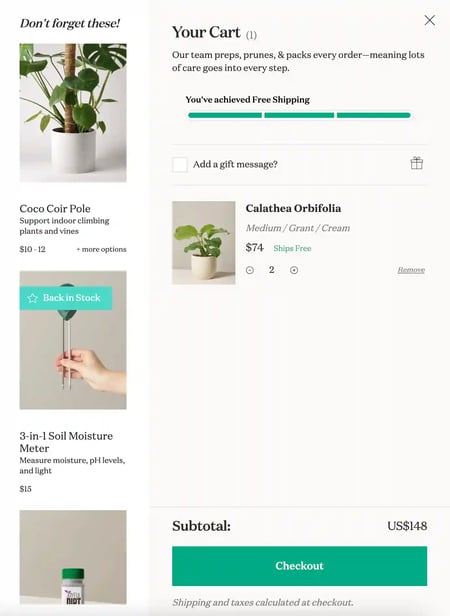 Image source: oberlo.com
Image source: oberlo.com
In this example, we can see The Still using this strategy by recommending products in a sidebar on the checkout page under the title “Don’t Forget These,” which is very catchy.
6- Provide customers with live chat support
Some customers need guidance and a little hand-holding while getting through the checkout process. Therefore, providing customers with live chat support is a checkout optimization strategy you should prioritize.
Make sure your live chat support has answers to all kinds of questions and inquiries that your customers might have during the checkout process so that they wouldn’t have to exit the checkout flow.
Fortunately, today, AI-powered chatbots, such as ChatGPT, can be easily integrated within your eCommerce store to provide around-the-clock customer support.
Example: Sephora
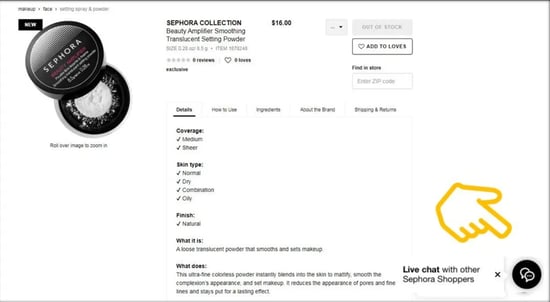
Sephora has a chatbot that offers real-time live chat support throughout its entire website. However, what distinguishes Sephora’s use of this checkout optimization strategy is that it allows its customers to communicate with other customers who can guide them through the checkout process and provide them with social proof.
7- Use FOMO Marketing
FOMO marketing is like a joker. It is a strategy that you can always implement and expect promising results. Checkout optimization is no exception. In other words, implementing FOMO marketing techniques can guarantee the optimization of your checkout process.
Psychological triggers that generate the fear of missing out fit perfectly on the checkout page. These triggers can be used on the checkout page in the form of the limited number of items left in stock, a limited-time special offer, or even a countdown timer.
Example: Minimum
 Image source: adoric.com
Image source: adoric.com
This international fashion brand uses FOMO marketing to optimize its checkout process by displaying exit-intent popups when a customer is about to leave the checkout page. It is like saying:
“Wait! Where are you going? Are you sure you want to abandon the checkout and miss out on our amazing offer?”
This checkout optimization strategy persuades customers to rethink their decision to abandon their shopping cart.
8- Make sure the checkout page is mobile-friendly
Mobile commerce is on the rise, and many online shoppers today prefer to use their mobile devices while shopping. Therefore, your eCommerce website, particularly your checkout page, should be responsive and have a mobile-friendly design.
Investing in a mobile-optimized checkout process yields many benefits for your eCommerce store, such as meeting customer expectations and increasing their satisfaction, maximizing conversion rates, and staying ahead of the competition.
Example: Amazon

Amazon is an online retailer that can be used as an example to learn from in many ways. One thing that makes Amazon exceptional is how it perfectly optimizes its checkout process for mobile devices. That’s why it is so convenient for many customers.
9- Explain the checkout flow and display a progress indicator
Don’t let your customers get lost!
One way you can guide your customers through checkout and optimize the entire process is by explaining how the process flows and showing customers where they are in that process.
You can always add a progress bar at the top of the checkout page to help customers keep track of the steps they’ve completed and the ones that are still to come.
When you do that, you give your customers an idea about what to expect while checking out, which removes the element of surprise and increases clarity and transparency. Also, the progress bar offers customers visual guidance throughout the checkout process, provides them with a much-needed sense of accomplishment, and encourages them to continue.
Example: Firebox
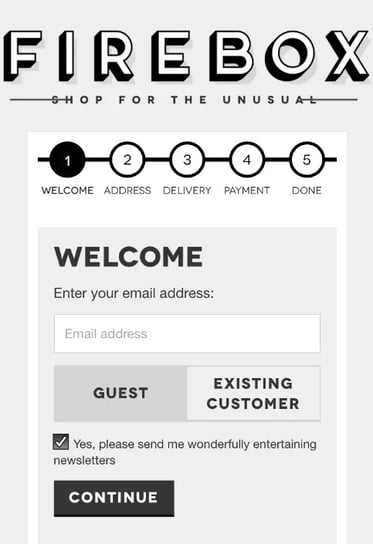
As a famous British online retailer, Firebox works hard on its checkout optimization. In the previous image, we can see a progress bar that demonstrates the checkout steps. We can also notice that the checkout here is mobile-optimized. Moreover, the store is not forcing customers to create an account by offering the “guest checkout” option discussed in the first strategy tackled in this article.
10- Make sure you collect customers’ emails in an early stage
Just because we advised you not to force your customers to create an account before checkout does not mean you can’t collect their emails. You can gather customers’ emails early in the process without asking them for other unnecessary information.
Collecting customers’ emails will allow you to follow up with them, retarget them, send them abandoned cart emails, and create strong relationships with them.
Example: Kensie
.webp?width=634&height=347&name=kense%20(1).webp) Image source: wisepops.com
Image source: wisepops.com
This eCommerce brand asks for customers' emails way before they reach checkout using a popup with a discount to incentivize customers and encourage them to enter their emails.
Additional Tips On Checkout Optimization:
- Keep the checkout process as short as possible. Try to use a one-page checkout whenever possible.
- If you have a multi-page or multi-step checkout process, make it easy to follow and understand.
- Be honest when mentioning the number of items left in inventory on the checkout page.
- Invest in your website design and remove any distractions that might divert customers from the checkout process.
- Your eCommerce website has to always auto-save the content of abandoned carts.
- Remember to complete your checkout optimization by sending post-purchase emails.
- There is no harm in offering free shipping from time to time.
- If you’re planning to offer product recommendations at checkout, personalize them.
Final Words:
In the eCommerce world, every detail can affect customers’ buying decisions. One of these details is the checkout process, which requires careful and regular optimization. Simply speaking, if you invest in checkout optimization, it will yield conversions. Conversely, if you overlook this crucial process, it will leave you with abandoned shopping carts.
 By
By
